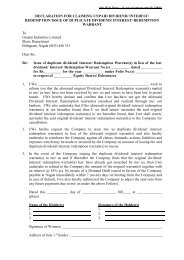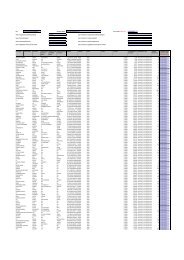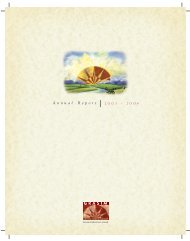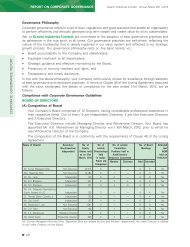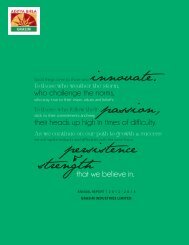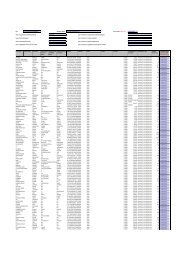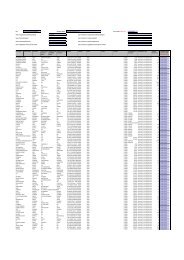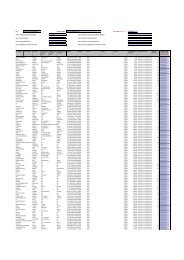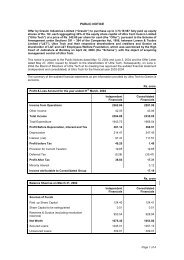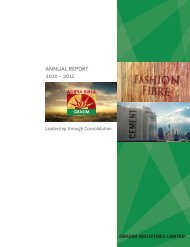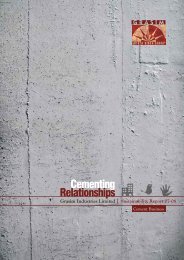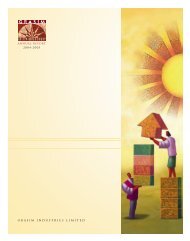2010-11 - Grasim
2010-11 - Grasim
2010-11 - Grasim
You also want an ePaper? Increase the reach of your titles
YUMPU automatically turns print PDFs into web optimized ePapers that Google loves.
GRASIM BHIWANI<br />
TEXTILES LIMITED<br />
SCHEDULE 20<br />
ACCO<br />
CCOUNTING POLICIES AND NOTES ON ACCO<br />
CCOUNTS<br />
A<br />
Significant Accounting Policies:<br />
1. Accounting Concepts:<br />
The financial statements are prepared under the historical cost<br />
convention on accrual basis and in accordance with the applicable<br />
mandatory Accounting Standards.<br />
2. Fixed<br />
Assets:<br />
Fixed assets are stated at cost (including other expenses related to<br />
acquisition and installation) less accumulated depreciation/<br />
amortisation.<br />
3. Foreign Currency<br />
rency Transactions:<br />
Foreign currency transactions are recorded at the exchange rate<br />
prevailing on the date of transaction. Monetary assets and liabilities<br />
in foreign currency existing at balance sheet date are translated at<br />
the exchange rate prevailing on that date. All other exchange<br />
differences are recognised in profit and loss account. Premium or<br />
discount on forward exchange contract is amortised as expense or<br />
income over the life of the contract.<br />
4. Treatment of expendit<br />
xpenditure during construction period:<br />
Expenditure during construction period is included under Capital Work<br />
in Progress and the same is allocated to the respective Fixed Asset<br />
on the completion of its construction.<br />
5. Inventories:<br />
Inventories are valued at the lower of cost or net realisable value<br />
except waste/scrap which is valued at net realisable value.<br />
The cost is computed on weighted average.<br />
Finished goods and process stock include cost of conversion and<br />
other costs incurred in bringing the inventories to their present<br />
location and condition. Obsolete, defective and unserviceable<br />
inventories are duly provided for.<br />
6. Researc<br />
esearch and development elopment expendit<br />
xpenditure:<br />
Revenue expenditure is charged to the profit and loss account and<br />
capital expenditure is added to the cost of fixed assets in the period<br />
in which it is incurred.<br />
7. Depreciation/Amortization:<br />
Depreciation/amortisation charge is provided for on the following<br />
basis:<br />
a) On fixed assets at Straight Line Method applying the rates /<br />
useful life specified in Schedule XIV of the Companies Act,<br />
1956, except as stated hereunder:<br />
Asset<br />
Estimated useful life<br />
Motor Cars<br />
5 years<br />
Computer Software<br />
3 years<br />
Furniture & Equipments<br />
7 years<br />
Furniture & Equipments for Showroom 5 years<br />
Computers<br />
4 years<br />
Telephone/ Mobile<br />
3 years<br />
b) In respect of assets added/disposed of during the Year on prorata<br />
basis with reference to the month of addition/deduction<br />
except in case of new projects where it is provided for on the<br />
basis of the period of use.<br />
8. Revenue enue Recognition:<br />
Sales revenue is recognized on transfer of the significant risks and<br />
rewards of ownership of the goods to the buyer and stated at net of<br />
sales tax, VAT, trade discounts, rebates but includes excise duty.<br />
Income from services is recognised as the services are rendered,<br />
based on agreement/arrangement with the concerned parties.<br />
Interest income is recognised on time proportion basis. Export<br />
incentives, certain insurance, railway and other claims, where<br />
quantum of accruals cannot be ascertained with reasonable certainty,<br />
are accounted on acceptance basis.<br />
9. Bor<br />
orro<br />
rowing Cost:<br />
Interest and other costs in connection with the borrowing of the<br />
funds to the extent related/attributed to the acquisition/construction<br />
of qualifying fixed assets are capitalised upto the date when such<br />
assets are ready for its intended use and other borrowing costs are<br />
charged to Profit & Loss Account.<br />
10.<br />
0. Employee Benefits:<br />
The Company makes regular contribution to provident fund and<br />
superannuation fund and these contributions are charged to Profit &<br />
Loss Account.<br />
Contributions to the Gratuity Fund and provision for leave encashment<br />
are made on the basis of actuarial valuation at the end of Year and<br />
charged to Profit & Loss Account.<br />
<strong>11</strong>. Pro<br />
rovision for Current rent and Defer<br />
erred<br />
red Tax:<br />
a) Provision for Current Tax is made on the basis of estimated<br />
taxable income for the current accounting Year and in<br />
accordance with the provisions as per Income Tax Act, 1961.<br />
b) Deferred Tax resulting from timing difference between book<br />
and taxable profit for the Year is accounted for using the tax<br />
rates and laws that have been enacted or substantially enacted<br />
as on the balance sheet date. The deferred tax asset is<br />
recognized and carried forward only to the extent that there is<br />
a reasonable certainty that the assets will be adjusted in future.<br />
12. Pro<br />
rovisions / Contingencies:<br />
A provision is recognized when there is a present obligation as a<br />
result of past event and it is probable that an outflow of resources<br />
will be required to settle the obligation, in respect of which a reliable<br />
estimate can be made. Provisions are determined based on best<br />
estimate of the amount required to settle the obligation at the Balance<br />
Sheet date. Contingent liabilities are not provided for and are<br />
disclosed in the Notes on Accounts.<br />
Rs. in lacs<br />
20<strong>11</strong> <strong>2010</strong><br />
B. NOTES ON ACCO<br />
CCOUNTS<br />
1.1 Contingent Liabilities not provided for in respect of:<br />
Claims not acknowledged as debts<br />
(includes demands in respect of<br />
Excise Duty, Cenvat Credit, Water Cess,<br />
Sales Tax/TAV, Electricity Duty etc.)<br />
Excise Duty 1464.85 1464.85<br />
Custom Duty 31.35 31.35<br />
Stamp Duty 433.80 433.80<br />
1.2 Estimated amount of Contracts remaining<br />
to be executed on capital account and<br />
not provided (Net of advance<br />
Rs. 53.97 Lacs) 80.81 6.75<br />
(previous year Rs. 4.46 Lacs)<br />
2. Advances recoverable in cash or in kind include :<br />
a) Payment made to employees by way of Loans and Advances<br />
in the nature of loan where there is<br />
Rs. in Lacs<br />
Outstanding as on Maximum Balance<br />
Outstanding<br />
31.03.20<strong>11</strong> 31.03.<strong>2010</strong> 31.03.20<strong>11</strong> 31.03.<strong>2010</strong><br />
No Interest or Interest<br />
below Section 372A<br />
of Companies<br />
Act, 1956 147.86 80.83 147.86 108.21<br />
147.86 80.83 147.86 108.21<br />
3 There are no Micro, Small and Medium Enterprises, to whom the<br />
Company owes dues, which are outstanding for more than 45 days<br />
at the Balance Sheet date. The above information has been<br />
determined to the extent such parties have been identified on the<br />
basis of information available with the Company.<br />
Rs. in Lacs<br />
4 Auditors’ Remuneration 20<strong>11</strong> <strong>2010</strong><br />
a) Statutory Auditors:<br />
Audit Fee 82725 75000<br />
Tax Audit Fee 27575 25000<br />
For Certification and other Work 22060 20000<br />
b) Cost Auditors:<br />
Audit Fee 55150 55150<br />
For Certification and Other Work<br />
Reimbursement of Expenses - -<br />
156



